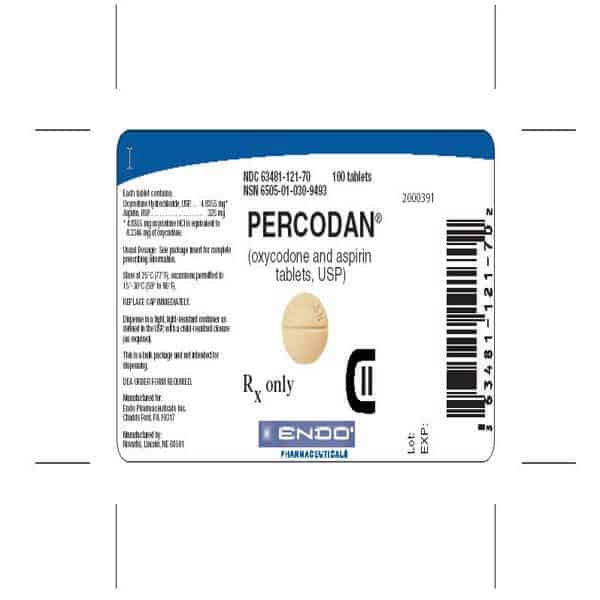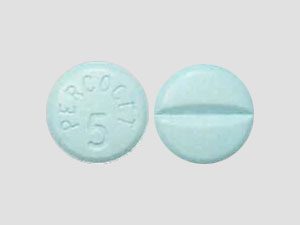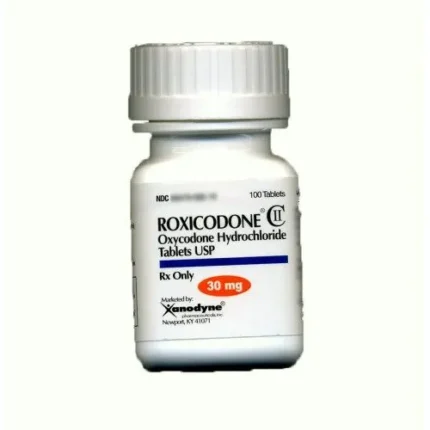What Is Percodan Pill?
Percodan is a combination medication designed to relieve pain by utilizing two active ingredients:
-
Oxycodone: A potent opioid that works by binding to opioid receptors in the brain, reducing the perception of pain.
-
Aspirin: A non-opioid analgesic that helps to reduce inflammation and pain by inhibiting the production of certain chemicals (prostaglandins) in the body.
This combination makes Percodan highly effective for managing moderate to severe pain, especially when other pain relievers have proven ineffective. It is commonly prescribed for pain after surgery, injury, or conditions such as dental pain.
Percodan vs. Percocet: Key Differences
Formulation Comparison:
-
Percodan: Contains Oxycodone + Aspirin.
-
Percocet: Contains Oxycodone + Acetaminophen (Tylenol).
Safety & Side Effects:
-
Percodan (Aspirin): Increases the risk of gastrointestinal irritation, ulcers, and bleeding.
-
Percocet (Acetaminophen): Poses a risk for liver toxicity when taken in excess.
Abuse & Overdose Risks:
-
Both medications carry the risk of addiction and respiratory depression due to the opioid component (Oxycodone).
-
Percodan adds an increased risk of bleeding complications due to the aspirin, while Percocet adds a risk of liver damage from acetaminophen.
How Percodan Works:
Percodan is used primarily for moderate to severe pain when non-opioid medications are insufficient. It works by:
-
Oxycodone: Relieves pain through its action on the central nervous system by binding to opioid receptors, which block pain signals.
-
Aspirin: Reduces inflammation and pain by inhibiting the COX enzymes that produce prostaglandins (the chemicals responsible for pain and swelling).
Dosage Instructions for Percodan
-
Typical Dosage: 1 tablet every 6 hours as needed for pain relief.
-
Maximum dosage: 12 tablets per day, but no more than 4g of aspirin should be consumed in a 24-hour period.
-
Do not exceed the prescribed dosage to avoid risks of overdose and adverse effects.
-
Consult your healthcare provider for personalized dosage instructions.
Warnings, Precautions & Storage
Addiction & Dependence:
-
Percodan contains an opioid (Oxycodone), which has a high potential for addiction, misuse, and overdose. Always use under medical supervision.
Serious Side Effects:
-
Respiratory depression
-
Gastrointestinal bleeding, ulcers, or perforation
-
Severe allergic reactions (e.g., anaphylaxis)
-
Anemia or unusual bleeding
Drug Interactions:
-
Avoid combining Percodan with CNS depressants, including alcohol, benzodiazepines, or other opioids, as it can increase the risk of overdose or respiratory failure.
-
Avoid other NSAIDs, blood thinners, or anticoagulants while using Percodan to reduce the risk of bleeding.
Special Precautions:
-
Not for children due to the risk of Reye’s Syndrome (associated with aspirin).
-
Use cautiously during pregnancy or while breastfeeding.
Storage:
-
Store at room temperature (68-77°F) in a cool, dry place.
-
Keep out of reach of children to prevent accidental ingestion.
Percodan Availability by State
Percodan (including the brand Endodan) is a Schedule II controlled substance regulated across the U.S. and may be subject to state-specific prescribing guidelines. Availability can vary depending on your location, so always check with a local pharmacy or healthcare provider for current availability.
FAQs – Percodan Pill (Oxycodone + Aspirin)
What is Percodan used for?
Percodan is primarily used to treat moderate to severe pain that is not well-controlled with non-opioid medications. It is commonly prescribed for pain after surgery, injury, or dental procedures.
What’s inside each Percodan tablet?
Each Percodan tablet contains:
-
4.8355 mg of oxycodone HCl (approximately 4.33 mg of the free base).
-
325 mg of aspirin (non-opioid anti-inflammatory).
Is Percodan still available in the U.S.?
Some formulations of Percodan have been discontinued. However, it may still be available in certain regions. Consult your healthcare provider or local pharmacy for availability.
How often can I take Percodan safely?
The recommended dosage is 1 tablet every 6 hours as needed. Do not exceed 12 tablets per day or 4 grams of aspirin within 24 hours.
How does Percodan differ from Percocet?
The primary difference is in the non-opioid component: Percodan contains aspirin, which may cause gastrointestinal issues, while Percocet contains acetaminophen, which may cause liver toxicity when taken in excess.
What are common side effects of Percodan?
Common side effects include drowsiness, nausea, dizziness, constipation, and stomach pain. Serious effects can include bleeding, respiratory depression, and severe allergic reactions.
What should I avoid while taking Percodan?
Avoid consuming alcohol, sedatives, blood thinners, and other NSAIDs. Always consult your doctor before combining with other medications.
What if I overdose on Percodan?
Symptoms of overdose include shallow breathing, slow heart rate, and unconsciousness. Seek immediate medical help if you suspect an overdose. Naloxone can reverse the opioid effects in case of an overdose.
Conclusion: Is Percodan Right for You?
Percodan is an effective pain management option for moderate to severe pain when non-opioid medications are insufficient. However, due to its potential for abuse, addiction, and serious side effects, it should only be used under strict medical supervision

 Best stimulant drugs
Best stimulant drugs Medical Psychedelics
Medical Psychedelics Pharmaceutical weight loss drugs
Pharmaceutical weight loss drugs Steroids for sale
Steroids for sale












Reviews
There are no reviews yet.